Breaking Down Thinktank-land's Latest: Estonian MoD & ISW Analysis
Two interesting thinktank policy papers were released over the past two weeks, which somewhat flew under the radar. I wanted to examine them in light of not only Ukraine’s now-announced major battlefield reorientation, but the general pivotal inflection point on which the conflict stands at the cusp of 2024, to see what projections for the future can be gleaned.
I read both of the papers so you don’t have to, so I’ll highlight the most important points and see how they can tie together into some semblance of a Western/NATO ‘strategic’ redirection.
The first of the two is from the Estonian Ministry of Defense, which has been active in various prognostications and reports from their supposed confidential ‘sources’ within the Russian MOD:
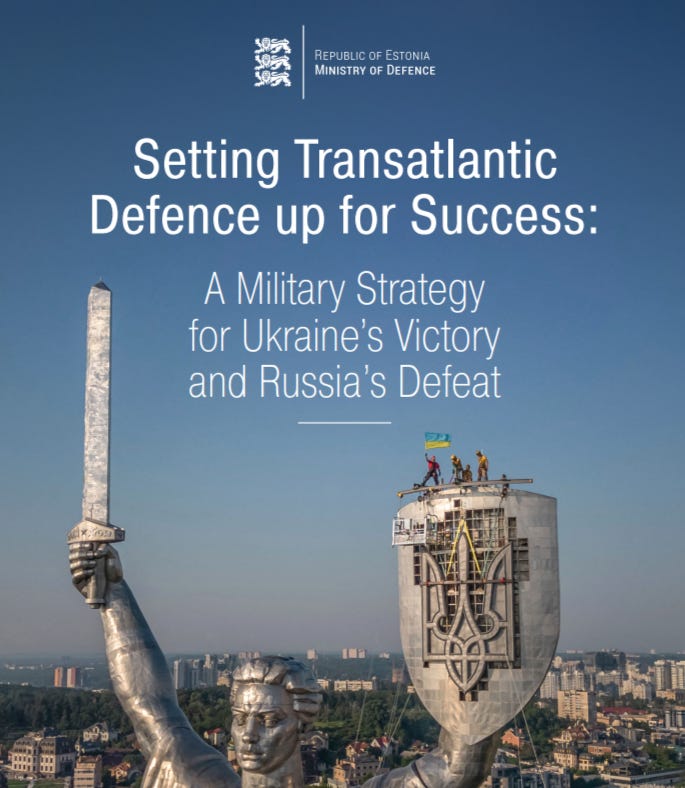
The gist of this paper revolves around hatching ideas for how Ukraine can use its reorientation period to rebuild into a force that can defeat Russia.
It begins with the same tired gloat of how much larger NATO/EU’s combined economies and military spending are over Russia. It’s a bit of a sophomoric take, as they expect this to innately convert into victory, as if it’s just a ‘given’ that “bigger is better.”
Note the key modifier “should”:
We are larger than the task. The sheer size of our collective political, economic and military power should guarantee a victory over Russia. The Ukraine Defense Contact Group (UDCG), also known as the Ramstein group, has a combined GDP of €47 trillion. Total commitments of military aid to Ukraine8 thus far are around €95 billion – 0.2% of that. At the same time, the combined defence budgets of the Ramstein coalition are more than 13 times greater than Russia’s heavily inflated one: €1.24 trillion against €0.09 trillion in 2023. There should be no doubt in who has the advantage to prevail.
They even provide this glossy chart:
I won’t rehash the obvious, but our recently discussed axiom applies here: you can print cash but not shells. (Well, mortar shells for drone-drops are in fact 3D-printed, in part, these days).
That being said, they somewhat acknowledge this—thus the exhortative leaning of the paper, meant to push allies into a bigger semblance of solidarity in order to increase their industrial productivity:
Most NATO Allies have significantly depleted their already small conventional military stockpiles and capabilities by donating their equipment to Ukraine. The Allies also have a very limited industrial base that is unfit for meeting the security challenges of the 21st century and unable to reconstitute these capabilities unless defence investments are substantially and urgently increased.
That’s a hell of a concession.
Where they begin to really drill down is on matters of frontline military, even offering some insightful nuggets. For example:
If undisrupted, Russia has the capacity to train approximately 130,000 troops every six months into cohered units and formations available for launching operations. Additional troops can be mobilised and pushed into Ukraine as untrained replacements, but these do not provide effective combat power.
This is a fairly powerful admission from a NATO source. They’re saying Russia can fully train and equip a massive 130k troops every 6 months into coherent units. They specifically make the distinction that this isn’t just an ability to round up some ragtag stopgap filler meat, but rather fully combat capable formations—which presupposes not only training but equipping. They even state Russia can raise many more additional troops, though those would amount to ‘untrained replacements.’
This represents a mouth-watering 6-7 divisions or 26 brigades every 6 months. Recall that Ukraine struggled to put together the 9 brigades for the sake of their big summer counteroffensive. If it was Russia claiming such numbers, Western pundits would laugh them out of the room. How can you possibly compete with a country that can raise 260k fully trained and combat capable men per year?
They go on to relay that Ukraine is incapable of training anything larger than company size on their own territory—a fact we’ve long known—due to fear of Russian precision strikes wiping out the entire muster. So they’re forced to train abroad, but the training there is often expedited and insufficient; for instance only 5 weeks long, whereas:
This is not sufficient to prepare soldiers for offensive operations. During the Second World War, British infantry would receive over 20 weeks of training before they were considered basically proficient and the U.S. Army operated with 13-17 weeks of basic training. We must therefore develop our training packages to better prepare our Ukrainian partners for offensive operations.
In the midst of this, they reveal another reality check as to Ukraine’s combat capabilities:
So, lacking trained officers, a Ukrainian brigade can only effectively control two companies, giving an entire AFU brigade only 1200 meters of usable coverage? Eye-opening as it may be, these numbers check out with things we’ve seen. For instance in the summer counteroffensive, even the most elite brigades like the 47th only ever appeared able to operate 2-company assaults at any given time.
But remember, the reason Russia is not completely overrunning them is because Russia itself is not necessarily completely up to snuff in this regard. Russian brigades too have many deficiencies, otherwise the war would have been over by now—they’re just no where near as bad as those of Ukraine, which reflects in the wide casualty disparity.
Also, as ever, the caveat is that this really only applies to offensive operations, which require high training and coordination abilities. Defense allows much more leeway, which means very poor Ukrainian brigades can still hold ground—despite suffering disproportionate losses—against qualitatively superior Russian brigades. The reason is that any deficiency can be made up for by simply plugging holes with more “meat”. Recall the video I recently posted of an AFU soldier recounting his battalion losing 350 men in only 8 hours. If you’re able to keep flooding the gaps with more meat, and the qualitatively superior enemy is not so inordinately superior as to be able to exploit the breakthrough in time, then the result will simply be that you’ll be heavily attritioned, but at least manage to hold ground and prevent breakthrough to the rear from happening.
Russian forces are qualitatively superior to a level where they can inflict hugely disproportionate losses, but not quite superior enough where they have the coordination and technology necessary to fully exploit those losses by way of maneuvers into the rear, through the breakthrough gap. In order to do that, you need absolutely inimitable and instantaneous communication and coordination between the various combined arms units, branches, command and control and ISR systems, etc. All must work in perfect unison to have full tactical and operational ‘awareness’ of everything that’s happening. This requires a lot of technology, most notably networking abilities via battlefield management systems that allow units to know what every other unit is doing in real time. Russia has these in places but it’s too checkered to create the complete technological overmatch and training required to really push through.
But in light of the report’s diagnosis of the AFU’s abilities, they prescribe the following:
In 2024, the aim should be to expand Ukrainian operations from brigade enabled company actions, to the ability to execute brigade attacks. In 2025, the aim should be for the AFU to conduct simultaneous brigade attacks, enabled by larger formations at a joint level.
They want Ukraine to be able to execute full brigade level maneuvers, with larger formations—which they say elsewhere don’t even exist in Ukraine at all presently; i.e. divisions and up.
This is a really big ask. To demand a failed state on the brink of collapse to somehow discover such capabilities is simply not feasible. Presently they’re not even capable of doing company-level attacks anymore; they’ve been reduced down to platoon size at best. So a realistic “2024-2025” goal would actually be getting Ukraine back to at least company level, if that—far from the mark idealized here.
Artillery
They again repeat the canard that Western 155mm artillery is superior to Russian in every way: range, rate of fire, and accuracy. Unfortunately, that may be true if you use a tiny sample size of a couple hundred fired rounds. Anything beyond that and we now know that precious and dainty Western artillery systems begin to badly degrade compared to legacy Soviet iron.
Recall:
Particularly look at the second one above. “Most of the [Western] mobile guns no longer work…”
The report proceeds to give some interesting figures.
Ukraine needs minimum 200,000 rounds per month to sustain ‘localized fire superiority’
The 2023 shell production of entire West is estimated between 480-700k—for the entire year
They go on to state something I’ve written about several times before, but it comes as another welcome confirmation:
Efforts to increase European production have been stymied by each European state pursuing separate – and relatively small – orders from industry. The business case presented by these orders does not justify defence manufacturers increasing production capacity, because there is no clarity on the scale of orders over time. European Allies and Member States therefore should work together to consolidate orders into larger and longer term contracts that would justify investment in production capacity in the defence industrial base.
Defense manufacturers are reluctant to increase their capacity because they fear their investment in these increases will not bear out, since there is no ‘clarity of orders over time.’ As I said before, it costs billions of dollars to increase capacity. You need new, very expensive lathes and forging machines; you need a huge amount of expensive training of personnel; potentially expensive expansions of your actual premises and sites, purchasing new land, factories, etc. All this costs huge money at a time when the economy is shot, energy prices are sky high, etc. We’ve learned recently that the average price of a single artillery round in Europe has skyrocketed from 4x to 8x in some countries.
But the most shocking admission of all? Feast your eyes:
That’s right—after spending a year downplaying Russia’s abilities, claiming they produce only 1 or sometimes at most 2 million shells, they now openly admit Russia has already reached 3.5M and will soon hit nearly 5M shells per year capacity.
Given the fact that there’s always high chance that any Western numbers on Russia are skewed downward and underestimated, there’s some possibility that these numbers are maybe even 15-20% higher in reality. Not only have I been saying these exact numbers all along, I predicted 7M capacity by end of 2024-2025, so such an evaluation would be on schedule for me.
And that doesn’t even count the 10M shells given by North Korea.
They continue with another interesting factor:
An additional limiting factor so far in the sustainability of Ukrainian fires is artillery barrels. It is assessed that Ukraine will need 1500-2000 barrels per year with each unit costing up to €900,000. Given the limited number of barrel machines, particular focus should be provided for companies to expand barrel manufacturing. The United States and the European Allies need to critically reassess the unsustainable fragmentation that has led to Ukraine using at least 17 different artillery platforms. The goal should be to reduce this number by several times.
Wait, you’re telling us they need 2000 barrels per year at a cost of $1M+ each? That’s $2 billion in barrels alone…
More interesting numbers: Lockheed’s capacity to produce GMLRS for HIMARS is apparently 10,000 per year, or ~800 per month. While this allows Ukraine to have an “okay” 24 to fire per day, imagine if it was the US itself embroiled in the war. Would 24 HIMARS rockets per day be enough for US’s 1000+ HIMARs launchers to fire? In essence, the US would run out of rockets instantly and have no ability whatsoever to keep up production.
Drones
There’s mostly pedestrian information here. One interesting revelation is in regard to Russian Shahed numbers:
So according to them, Russia used to build 40 Shahed/Geran drones per month, now does 100, and will soon do 200 per month. Also, another confirmation of something I’ve been saying for nearly a year now, but which untrained pro-UA/Western pundits always deny: that Western interceptors need to fire 2 missiles to take out a target.
Though 200 drones per month is a big increase, it still only allows a few decent-sized strikes each month, as you typically need to send at least 20 at a time to have any effect in overwhelming the AD—anything less and they can be easily picked off. I suppose a 50 drone strike once per week, for 4 per month is pretty good. However, if they can get it to a level where it’s possible to do a 20-30 drone strike once every 2-3 days consistently, then Ukraine will really feel the pain. That would require something like 450 drones built per month. But even so, what they have now is definitely big progress.
The rest of the report provides little else of interest. In fact, the report as a whole mostly amounts to just asking for more money and more things, banking on an increase of wunderwaffen, as usual, being the gamechanger. They set great store in quantity of toys over any actual sound strategic plan. In short, their message is, as long as we can keep pumping gear into Ukraine we’ll win—we don’t need any battlefield strategy.
This unfortunately stems from the continued misapprehension, and underestimation, of Russian capabilities. Russia remains viewed by the ‘West’ as backward and capable only of ‘meat assaults’—a sort of glorified zombie horde from one of those videogames where, as long as you have enough ammunition, you can stop them at the gates.
This entirely ignores all manifestations of strategic thinking, development, and advancement that Russia itself is engineering day in and out. In a poignant bit of inadvertent symbolism, the report ends with this photo of a disabled veteran in Kiev:
ISW
The second and far more interesting article is from well-known thinktank ISW:
As many know, ISW (Institute for the Study of War) is a DC-based neocon cutout run by Kimberly Kagan, sister-in-law to PNAC neocon Robert Kagan, husband to Victoria Nuland. In fact you can see the report itself is undersigned by Robert’s brother, Frederick W. Kagan as well.
This report is much more significant as it truly signals and underlines the real intentions of the beltway gang and deepstate goons, giving us rare insight into the specters haunting their minds, and the ramifications of that on the long-term strategic outlooks of the conflict—particularly if Russia should win, which is the great ‘peril’ the report revolves around.
They begin straightaway, pulling no punches, with a major series of admissions:
The United States has a much higher stake in Russia's war on Ukraine than most people think. A Russian conquest of all of Ukraine is by no means impossible if the United States cuts off all military assistance and Europe follows suit. Such an outcome would bring a battered but triumphant Russian army right up to NATO’s border from the Black Sea to the Arctic Ocean.
Once again, beneath the gestural gloss of media headlines, which have to push a plum narrative slant for the plebs—like that, at best, Russia stands to claw out a ‘freezing of the lines’—we see the real movers and shakers within the MIC machineworks envision Russia conquering all of Ukraine, if aid is stopped.
They go on with more heavy hits:
In essence, they’re admitting that a victorious Russia will be the most formidable force since the end of the Cold War. But here’s the kicker to why this specter terrifies them so:
To deter and defend against a renewed Russian threat following a full Russian victory in Ukraine the United States will have to deploy to Eastern Europe a sizable portion of its ground forces. The United States will have to station in Europe a large number of stealth aircraft. Building and maintaining those aircraft is intrinsically expensive, but challenges in manufacturing them rapidly will likely force the United States to make a terrible choice between keeping enough in Asia to defend Taiwan and its other Asian allies and deterring or defeating a Russian attack on a NATO ally. The entire undertaking will cost a fortune, and the cost will last as long as the Russian threat continues—potentially indefinitely.
There’s the rub. Recall for how long I tried to educate people about how military doctrine works. There are certain safety levers in place, that must trigger automatically when your opponent makes a move. It’s not a matter of a politician, like a president, making a momentary choice, or something that must be ‘decided on’. No, it’s written into the doctrine with the selfsame ‘code’-like certainty of programming language. If X amount of forces move in and threaten you, you have no choice but to stage Y amount of your own preventative forces.
This is why Russia had no choice but to immediately draw up a massive 500k new army on the eve of Finland and Sweden joining NATO this year, with the resumption of the Moscow and Leningrad Military Districts which were discontinued long ago. It’s simply unthinkable for a nation to have hostile armies directly on its borders without anything there to counteract them.
Similarly here, the US MIC enjoyed the luxury of various proxies keeping Russian military forces constrained and occupied, so the US could divert its strength elsewhere toward maintaining its hegemony around the world. But now, a total, decisive Russian victory in Ukraine stands to undo all that, and, in their own words, would require the US to station “a sizable portion of its ground forces” in Eastern Europe.
This would represent a major fly in the ointment of US plans, particularly vis a vis China, given what they write next—that they would have to manufacture and station large amounts of stealth aircraft in Europe, which would foil their Taiwan designs. In short, they argue that a Russian victory would bankrupt the MIC, requiring an unsustainable new level of military escalations.
Almost any other outcome would be better, they write:
Almost any other outcome of the Ukraine war is preferable to this one. Helping Ukraine keep the lines where they are through continuous Western military support is far more advantageous and cheaper for the United States than allowing Ukraine to lose. “Freezing” the conflict is worse than continuing to help Ukraine fight—that would simply give Russia time and space to prepare for a renewed war to conquer Ukraine and confront NATO.
These words wouldn’t be so weighty if they weren’t issued from the very maw of the beast itself—the most powerful neocon deepstate ‘shadow elite’ which has run the US MIC for decades, and which therefore speaks on its very behalf. If you read carefully, there’s an almost desperate urgency in their tone—which is extremely telling.
They go on to map the potential scenarios for how the war could play out:
Situation 1: Pre-February 2022
They use the above map to illustrate that prior to 2022, Russia ‘posed no threat’ to any non-Baltic NATO state, as Russia—according to them—“had one airborne division and a mechanized infantry brigade near the Estonian and Latvian borders and the equivalent of a division in the exclave of Kaliningrad… No Russian troops threatened Slovakia, Hungary, or Romania.”
Further, they claim Russian AD networks had large gaps for southern Poland, Slovakia, Romania, Hungary, etc., because Russia could not place AD systems in Ukraine:
What’s remarkable thus far, is how little regard is paid to any other country’s national security interests, besides the US. You see, there’s an existential tone when it comes to discussing any Russian assets that could even remotely pose some type of threat, or be somewhere pressed up against, NATO territory. Yet the fact that NATO can just nonchalantly coast eastward and place entire armies right on Russia’s doorstep is to be totally dismissed—this is the “rules based order” they keep telling us about: it amounts to rules for everyone else, while the US gets to dominate the world in lawless fashion.
In fact, they even openly advocate for outright economic coercion, which in any other parlance is outright terrorism or political interference in a country:
• It is a priority to move from the passive passing of sanctions to their proactive and aggressive enforcement, combined with the use of economic coercion to constrain trade with Russia
Keep in mind, the coercion they’re referring to is against their own allies. Russia is already coerced, so it isn’t in reference to them. No, they want to amp up coercion of intransigent EU/NATO allies or any other associated country to crack down on Russia’s defiant sanctions-circumvention regime.
Now that they’ve set the stage for scaremongering their audience, they move onto the final part: showcasing what would happen if Russia were to fully occupy Ukraine after a decisive victory.
First, they somberly repeat this warning again—to really hammer home the seriousness of the threat:
The sudden collapse of Western aid would likely lead sooner or later to the collapse of Ukraine’s ability to hold off the Russian military. Russian forces could push all the way to the western Ukrainian border in such a scenario and establish new military bases on the borders of Poland, Slovakia, Hungary, and Romania. The Russians are preparing occupation military forces to handle the almost inevitable Ukrainian insurgency while leaving front line troops free to threaten NATO.
Again I’d like to note—because it’s of such utmost importance—the huge, 747-sized disparity between what’s allowed to be reported for mass consumption, and what’s actually discussed by the real planners and strategists of the war. Once more you see the completely candid admission that if Western aid is cut off, Russia will not only win, it will push all the way to the western Ukrainian border. Contrast this totally startling admission with what’s allowed in the surface-level discourse, where it’s still verboten to so much as propose that Russia may ‘break the stalemate’ even at the local level, advancing to perhaps the Dnieper, or something along those lines.
The Russians have expanded their army’s structure to fight the war and have indicated their intention of retaining the larger structure after the war.[5] They could readily station three full armies (the 18th Combined Arms Army and the 25th Combined Arms Army newly created for this war and the 8th Guards Combined Arms Army) on the borders of Poland, Hungary, Slovakia, and Romania.[6]
Wait a second, so the completely dead, battered, beaten and defeated, poor Russian army, who—according to MSM—had had 95% casualties thus far, is suddenly able to muster 3 entire full-fledged field armies just for the task of securing the Polish border? That is a veritable universe of difference with what’s allowed for public consumption.
In fact, it’s absolutely dizzying what they now claim Russia will be able to muster along the entire NATO front:
Where are all these hundreds of divisions suddenly coming from? Ah, but you see, that’s the power of propaganda. It only goes to show that virtually everything we see is just grist meant for the public consumption mill, intentionally designed and targeted propaganda meant to downplay Russian forces in every way conceivable—from their quantity to quality, to everything in between.
But the real planners, the gray eminences behind the curtain, see what they conceal from us—massive, unprecedented Cold War-era Russian buildups that are not being attritioned in any appreciable way in Ukraine.
And so comes the next bombshell:
NATO would be unable to defend against such an attack with the forces currently in Europe. The United States would need to move large numbers of American soldiers to the entire eastern NATO border from the Baltic to the Black Sea to deter Russian adventurism and be prepared to defeat a Russian attack. The United States would also need to commit a significant proportion of its fleet of stealth aircraft permanently to Europe. NATO defense strategy relies on air superiority not merely to protect NATO troops from enemy attack but also to use air power to offset smaller NATO ground forces and limited stocks of NATO artillery. The United States would have to keep large numbers of stealth aircraft available in Europe to penetrate and destroy Russian air defense systems—and keep the Russians from re-establishing effective air defense—so that non-stealthy aircraft and cruise missiles can reach their targets. The requirement to commit a significant stealth aircraft fleet to Europe could badly degrade America’s ability to respond effectively to Chinese aggression against Taiwan since all Taiwan scenarios rely heavily on the same stealth aircraft that would be needed to defend Europe.
So now we get to the real truth about why the earlier-mentioned stealth fleets are so necessary. You see, they admit that NATO have no real ground forces to speak of, nor any artillery left, after giving it all to Ukraine—not that they had much to begin with. In fact, NATO is nothing more than a fragile glass jetfighter masquerading as a military alliance.
But the problem is, they admit that Russian air defense networks are so dense their airforce will not be able to penetrate it without the help of stealth fighters, which are not only fairly limited, but are also critically needed for the Chinese-Taiwan front.
There are so many things to be said about stealth craft it could take an entire series of articles, let alone one article or even a few paragraphs. But one thing I’ll say here is that stealth aircraft degrade very quickly without major upkeep and maintenance, which is impossible in high intensity conflict. For instance, their RAM coatings need to be reapplied every few missions, which takes huge amounts of manpower and time—something that will absolutely not be available in a real conflict. Once those coatings are gone, the planes will be extremely visible to radars, as the US itself admits that the RAM coating is responsible for a large portion of modern stealth crafts’ ‘stealth’ abilities—particularly in the new B21 Raider.
That means the longer such a conflict goes on, the less stealth and more vulnerable US’s only existing ‘ace in a hole’ gets. Which means once more, Russia retains the advantage and will get progressively stronger as the conflict goes on—just like in Ukraine.
But to continue on—the outlook only gets worse:
The cost of these defensive measures would be astronomical and would likely be accompanied by a period of very high risk when US forces were not adequately prepared or postured to handle either Russia or China, let alone both together.
Wait, so the US wouldn’t even be able to handle one of them, let alone both? You know things are getting extremely desperate when they’re forced to come clean on admissions of this size and magnitude.
Here’s how they foresee the map looking once Russia takes control of all Ukraine. First the dispositions of armor and mechanized divisions:
Next, the new IAD air defense networks, which would now overlay a significant part of “NATO territory”:
Finally, they go onto their “dream scenario” for a total Ukrainian victory, which is obviously impossible and has literally a zero chance of happening—thus making it irrelevant to even cover in depth. However, there is one major point they openly affirm:
And there it is—full, naked, and out in the open. The real objective for NATO’s grubby hands revealed at last without art or varnish:
“The Black Sea would become very nearly a NATO lake.”
This is their lifelong, unrealized dream, fully confirmed in print at last. There really isn’t much more to say after this because this admission alone validates every single step Russia has taken in this conflict thus far. It fully exonerates Russia of any misdeed as it proves without question that NATO has always sought nothing more than to surround and strangulate Russia from every side, robbing it of land and treasure.
Part 2
This first part was from December 14th, but today ISW released the second part of their analysis, which continues the trend. I won’t cover it in as much depth mostly because it tediously rehashes the same points, as if to drum them home, further evincing their own desperation and urgency.
However, there are a few very cogent points to note.
First, they again contradict the current narrative by assessing that cutting aid would not result in a mere ‘stalemate’ as CNN and co. would like you to believe, but rather it will end Ukraine’s ability to hold Russia off, leading to Russia simply overrunning them:
A self-imposed defeat in Ukraine will confront the United States with the real risk of another war in Europe with higher escalation risks and higher costs. Cutting aid to Ukraine will not freeze the frontlines, as ISW has assessed.[2] It will instead diminish Ukraine’s ability to hold off the Russian military and accelerate Russia’s military drive further and further west because the fundamental driver of this war — the Kremlin’s intent to eradicate Ukraine’s identity and statehood — has not changed.
Second, they dispel another popular narrative in the West—one that says Russia will be left ‘gravely weakened’ after this war, picking up the strewn wreckage of whatever destroyed territories they managed to annex. In fact, I’ve said since the beginning Russia is gaining immeasurably more than they’re losing: in new populations, land and resource wealth, etc. ISW agrees:
Absorbing parts of Ukraine and Belarus would significantly increase Russia’s power, adding millions of people, including the skilled labor and industrial assets that remain and the territory not scorched, for the Kremlin to use for the reconstitution of the Russian military.
They go on to once more strike a weighty note, implying that NATO itself is on the line:
The future of NATO is bound up with the future of Ukraine much more tightly than most people understand.
Not only are they suggesting NATO could break entirely, but for those who needed to hear it from a more “authoritative” source, they validate what Scott Ritter and myself have been harping on for a long time now—that Article 5 means nothing. Without the will to actually act, it does not legally obligate countries to do much of anything, particularly in defense of a country whose only ties to NATO are quite artificial, and whom they really couldn’t care less about.
Next, they make another fairly startling and counterintuitive admission—that Russia’s greatest strength is in fact its dominance in the information sphere. Who would’ve thought that? The media influencers tell us it’s the complete opposite: Russia is an ‘isolated laughing stock’ on the world stage, their propaganda ploys falling flat like a bad comedy routine at a dive bar. But once more, under the surface, a different tune is being sung, and the real shakers are overwhelmed and intimidated by the force of Russia’s informational 5GW accomplishments:
But here they give up the plot, getting to the heart of the entire matter. They outline what is in their mind the gravest threat of all: that Russia could single-handedly change America’s perception of itself, nay, change the very idea of what America is:
Altering America’s will is no small thing. America is an idea. America is a choice. America is a belief in the value of action. US domestic resilience and global power come in no small part from people and countries choosing the United States and from Americans preserving their agency to act with intent. An adversary learning how to alter these realities is an existential threat — especially when ideas are that adversary’s core weapon.
Ah, and now we get to the metaphysics of it all. You see, the sheep’s been shorn, baring its ass for all to see, and only the truly keen can glean the deep esoteric secrets revealed therein.
What they’ve just outlined goes beyond the bourne of any such paltry material matters of warfare and all things corporeal. In fact they’ve unveiled the very ontological essence of the Empire’s global hegemony, and it’s something that was coincidentally evoked earlier today in Andrei Martyanov’s blog, which I happened to synchronistically pass over. His piece itself is thought-provoking and very good—which I recommend you read—however it’s the top comment which strikes at the heart of things like a paean:
I’ll reprint the evocatively-worded bottom portion for effect:
America the Myth floated along during all of this. It was a shared catechism of the American religion, but is becoming harder to swallow. We are becoming American Atheists and when the people stop believing in their own myths they perish.
Now let’s see Kagan and cohort’s exegesis one more time, side by side:
Altering America’s will is no small thing. America is an idea. America is a choice. America is a belief in the value of action. US domestic resilience and global power come in no small part from people and countries choosing the United States and from Americans preserving their agency to act with intent. An adversary learning how to alter these realities is an existential threat — especially when ideas are that adversary’s core weapon.
Ah….so there it is. You see, American power is enshrined in nothing more than a Myth of supremacy and entitlement, one itself cloaked in various euphemistic coys and vapory misdirections like “the rules based order.”
What the neocons have revealed here is the master key to everything: Russia stands to shatter the Myth, or rather the Grand Lie, which enshrines not the true America that once was, but the pedestaled neocon distortion of it—what it has become, the warped behemoth, the ungainly Leviathan thrashing the entire world with its spurred tail and noxious breath.
These freaks, which have co-opted the country and its foreign policy, have in fact turned America into nothing more than a shambling golem, one without clothes like its shadow emperor. They now fear nothing more than for Russia to shatter this displaced “idea”, this fraudulent, barnacled ‘dream’ which exists only in the blood-addled minds of the neocon usurpers. This would shatter the illusion once and for all, not only freeing the globe from the Leviathan’s grasp, but destroying the age old neocon pursuit.
Note the very peculiar idiomatic use of: “alter these realities.” You see, to “alter” the neocons’ imposed surrogate reality is to destroy the beast once and for all, to amputate the stricken cancerous growth strangling the heart of what was once ‘America’. This is what they fear, and they’ve elocuted it as best they can, encoded in symbolism. The America they’ve concocted exists as a simulation in a matrix, and they fear Russia has found the key to unplugging their false construct-reality, awakening an entire generation to the actual truth: that the country and everything it ever stood for has been entirely hijacked by a criminal cabal.
Most of all, they’ve revealed that “America’s” power relies on a spell cast over its closest ally, the completely subjugated Homo Europaeus. Once Russia “shatters” this spell, it’s game over.
US domestic resilience and global power come in no small part from people and countries choosing the United States and from Americans preserving their agency to act with intent.
The ‘sacred’ idea of America distilled here is nothing more than an imperial illusion, a web cast over the eyes of a European continent that’s been under total occupation since the end of WW2. What they’re saying, ultimately, is—there is no inherent sacredness to this manufactured ideal of theirs, but rather it’s an enforced illusion, that’s as brittle as chalk once people are awakened to it. And they believe Russia’s powers of awakening are an existential threat.
Dark stuff, I know. But this is why their tone is so evidently shrill and vexatious in this desperate report.
Russia has cornered the rats and they’re panicking.
Your support is invaluable. If you enjoyed the read, I would greatly appreciate if you subscribed to a monthly/yearly pledge to support my work, so that I may continue providing you with detailed, incisive reports like this one.
Alternatively, you can tip here: Tip Jar



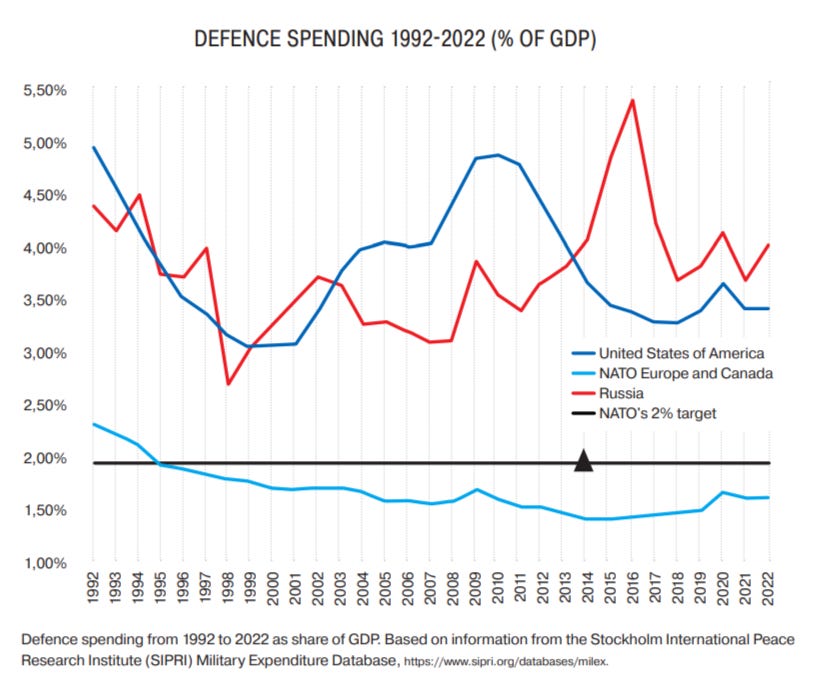
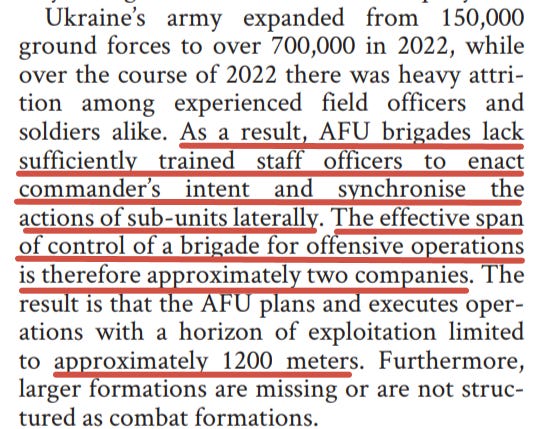
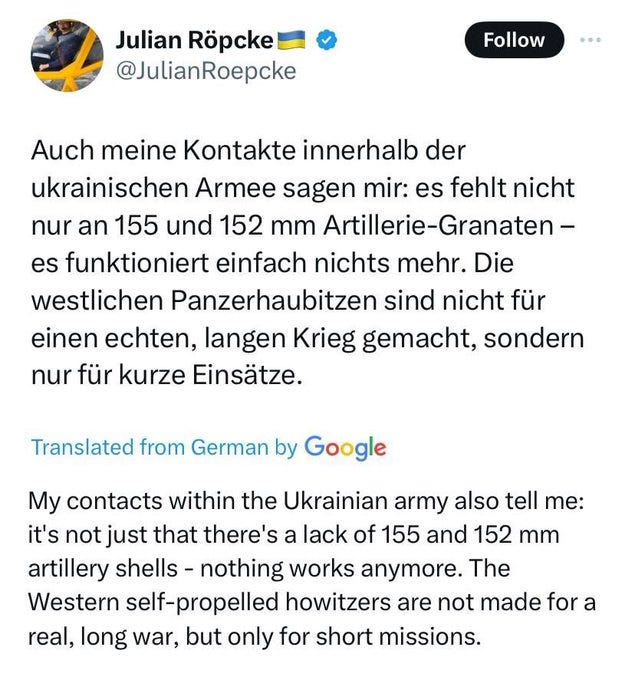
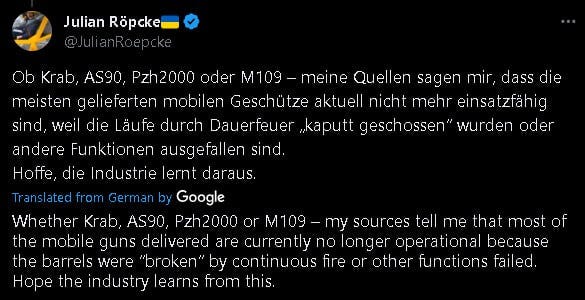
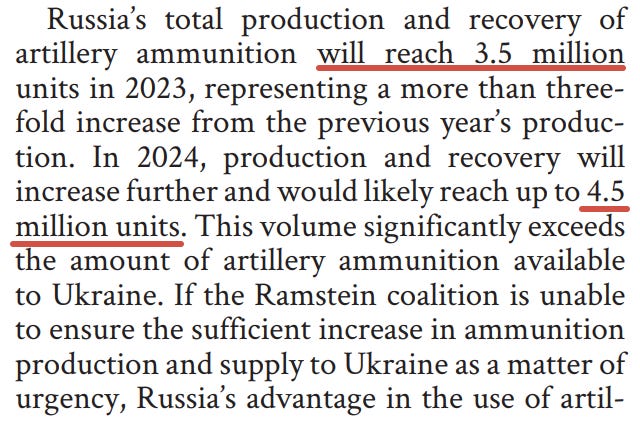
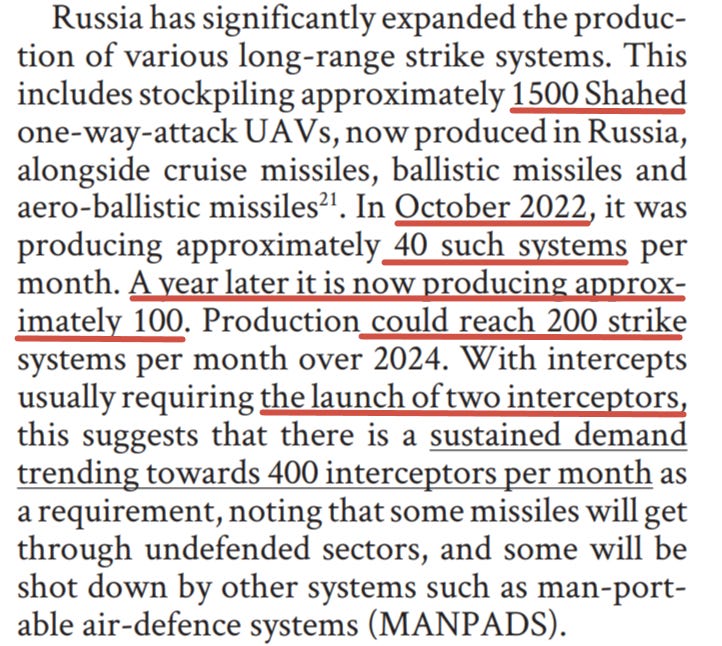
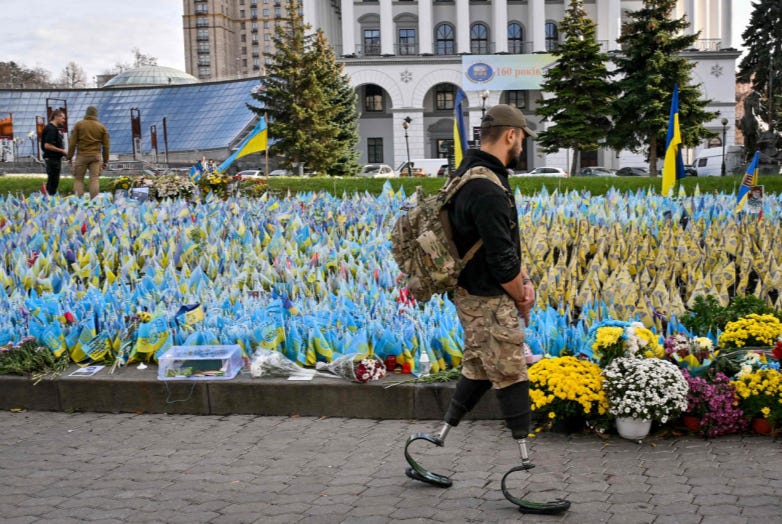
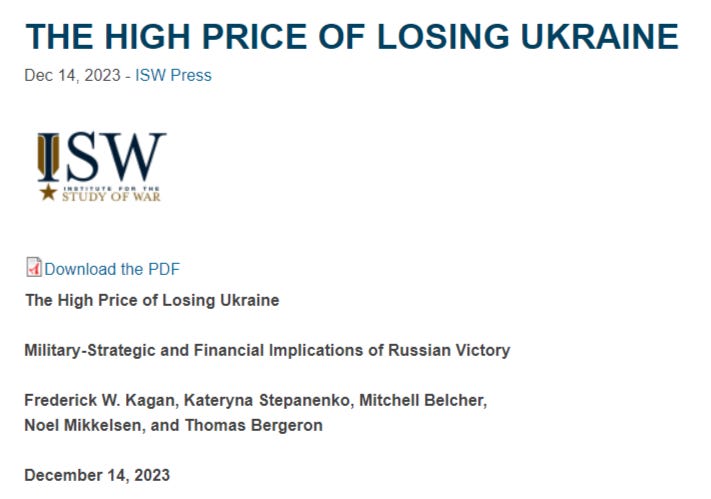
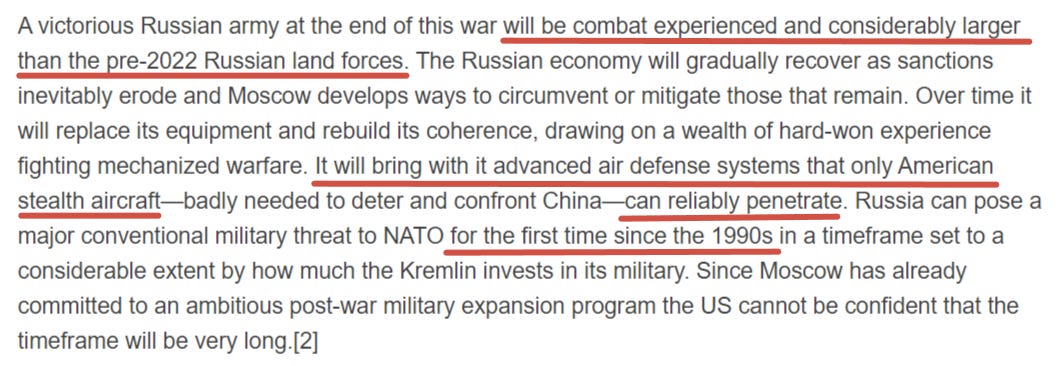
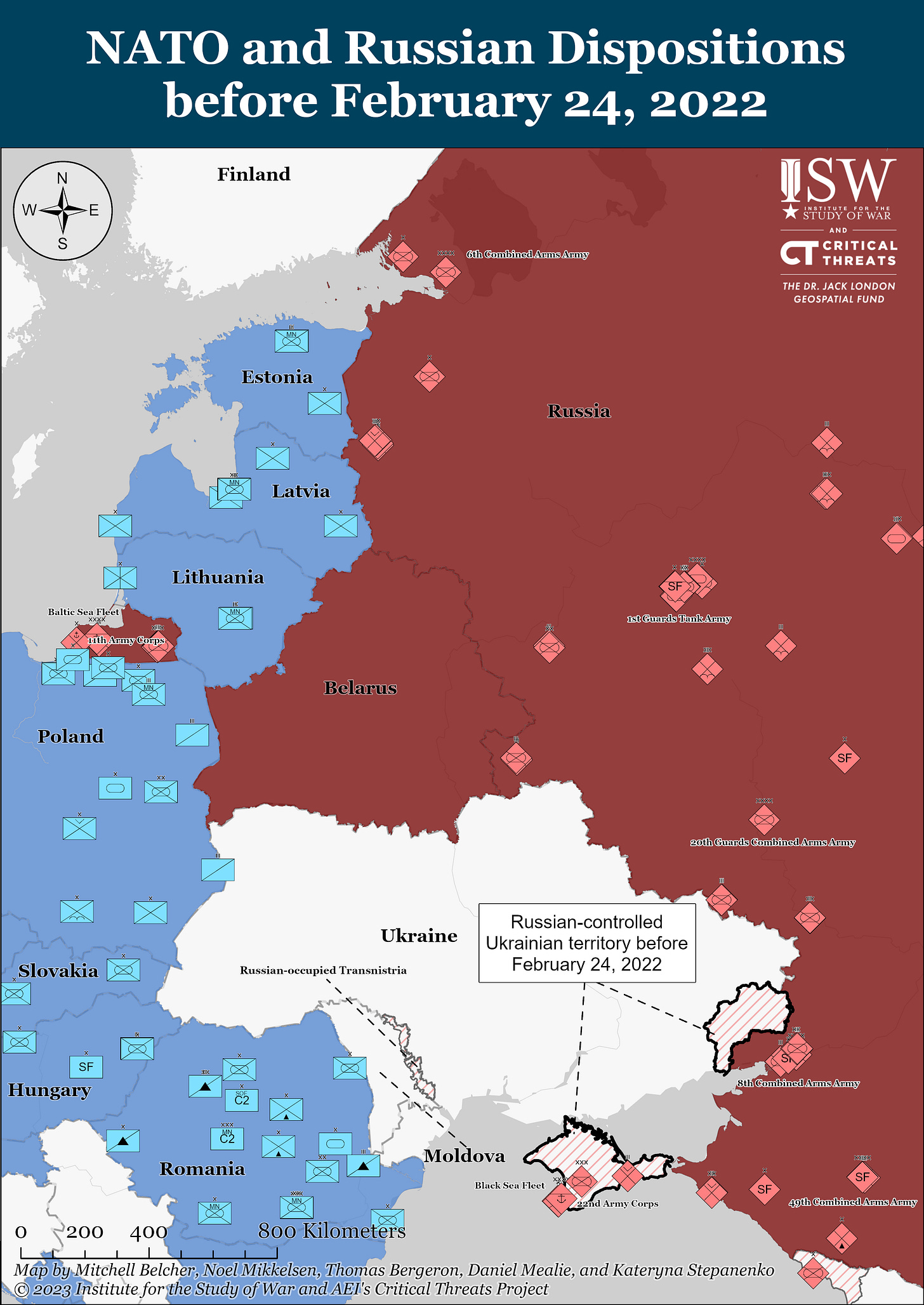
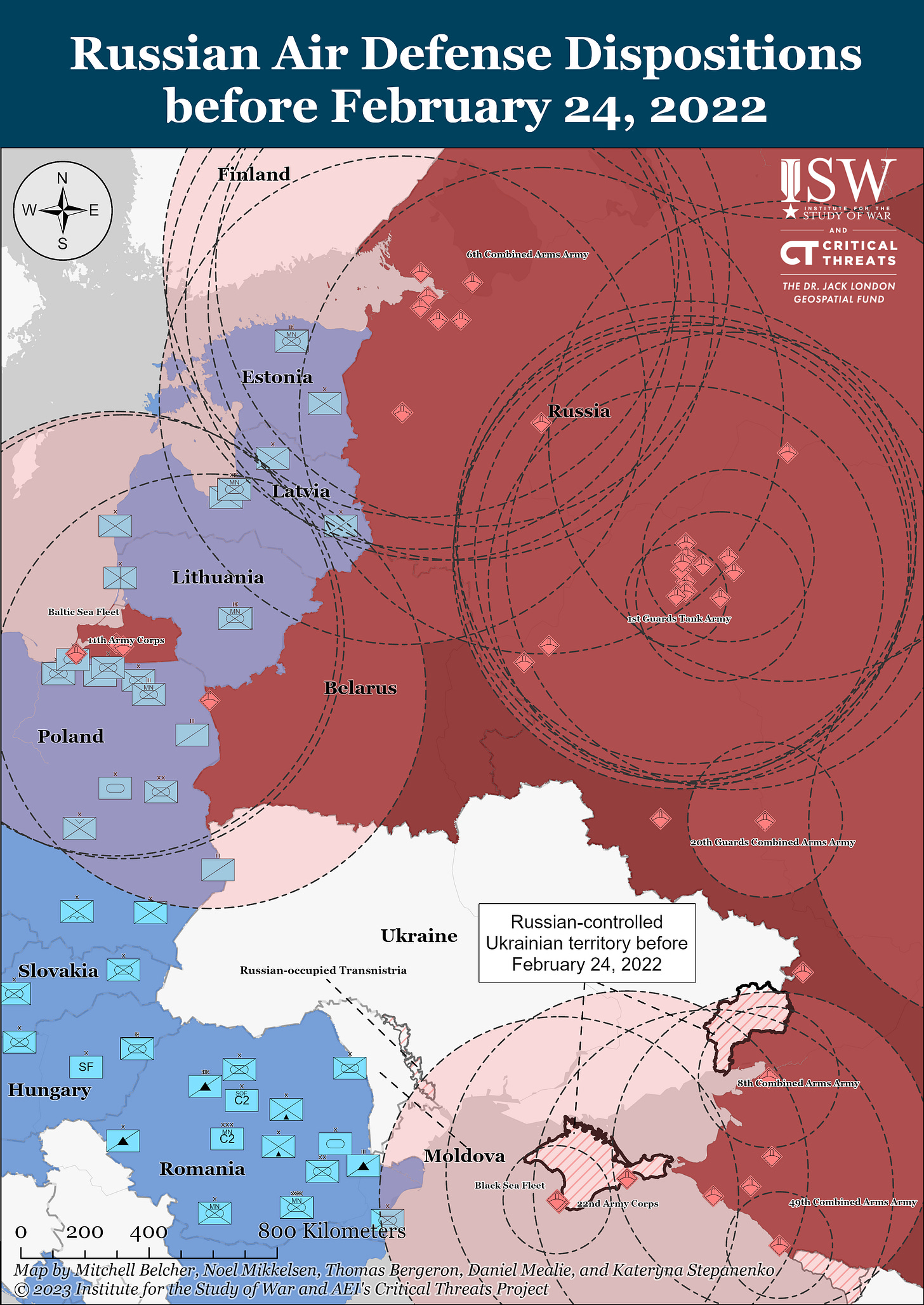
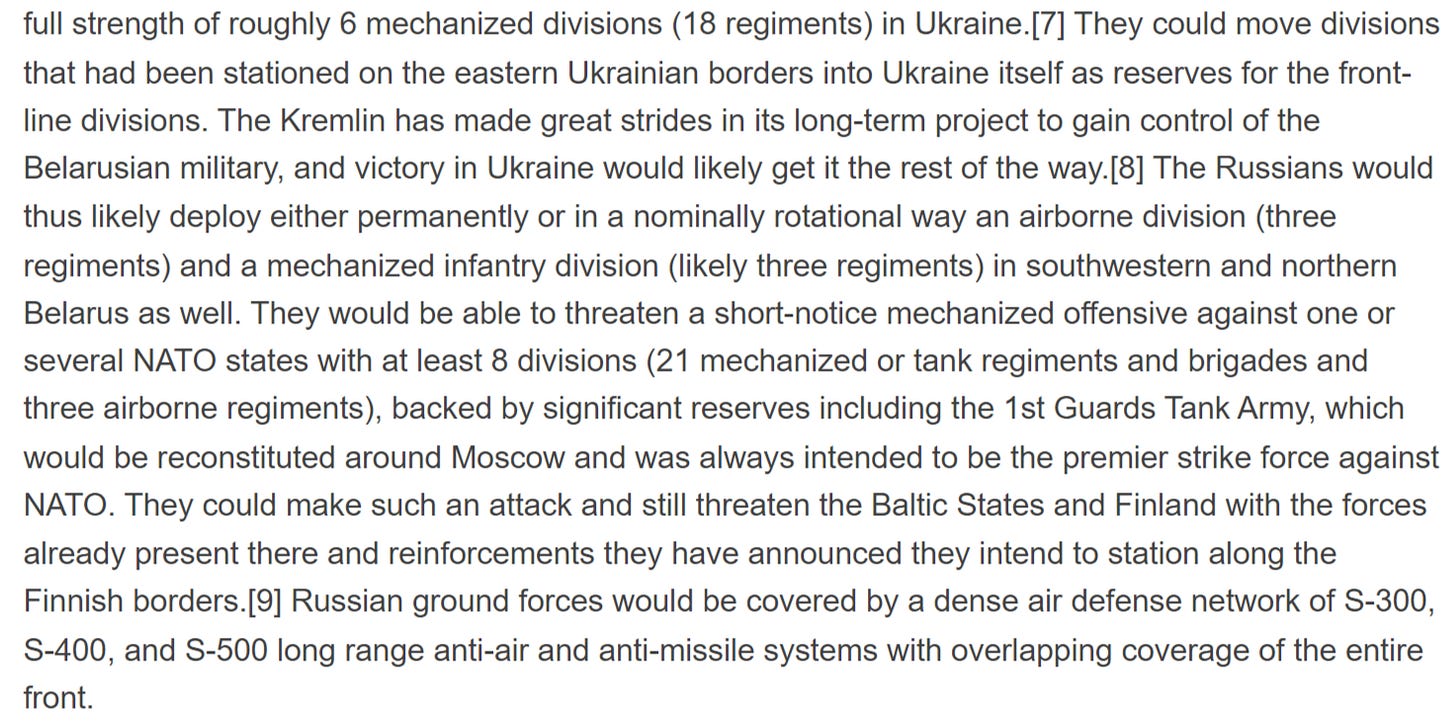
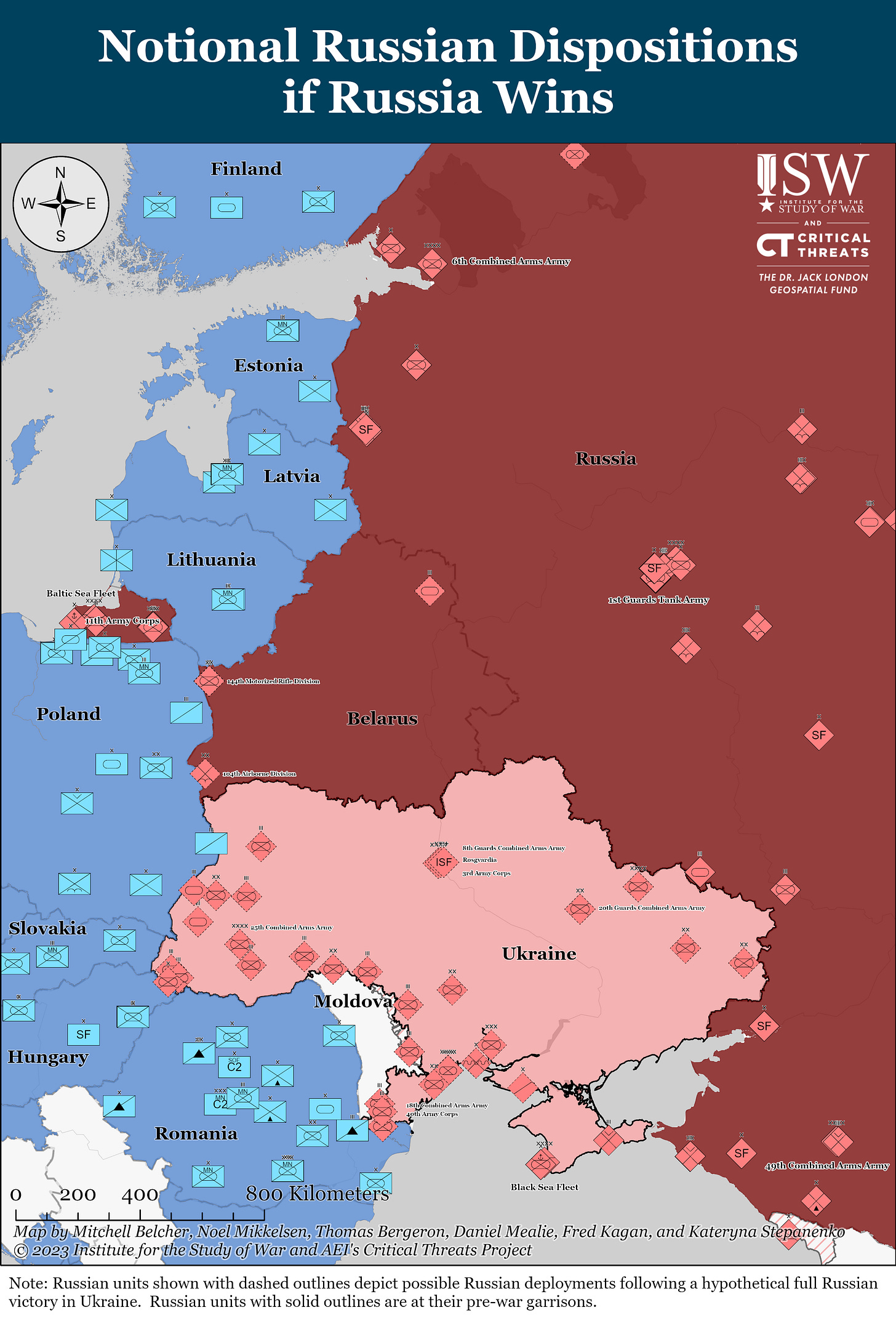
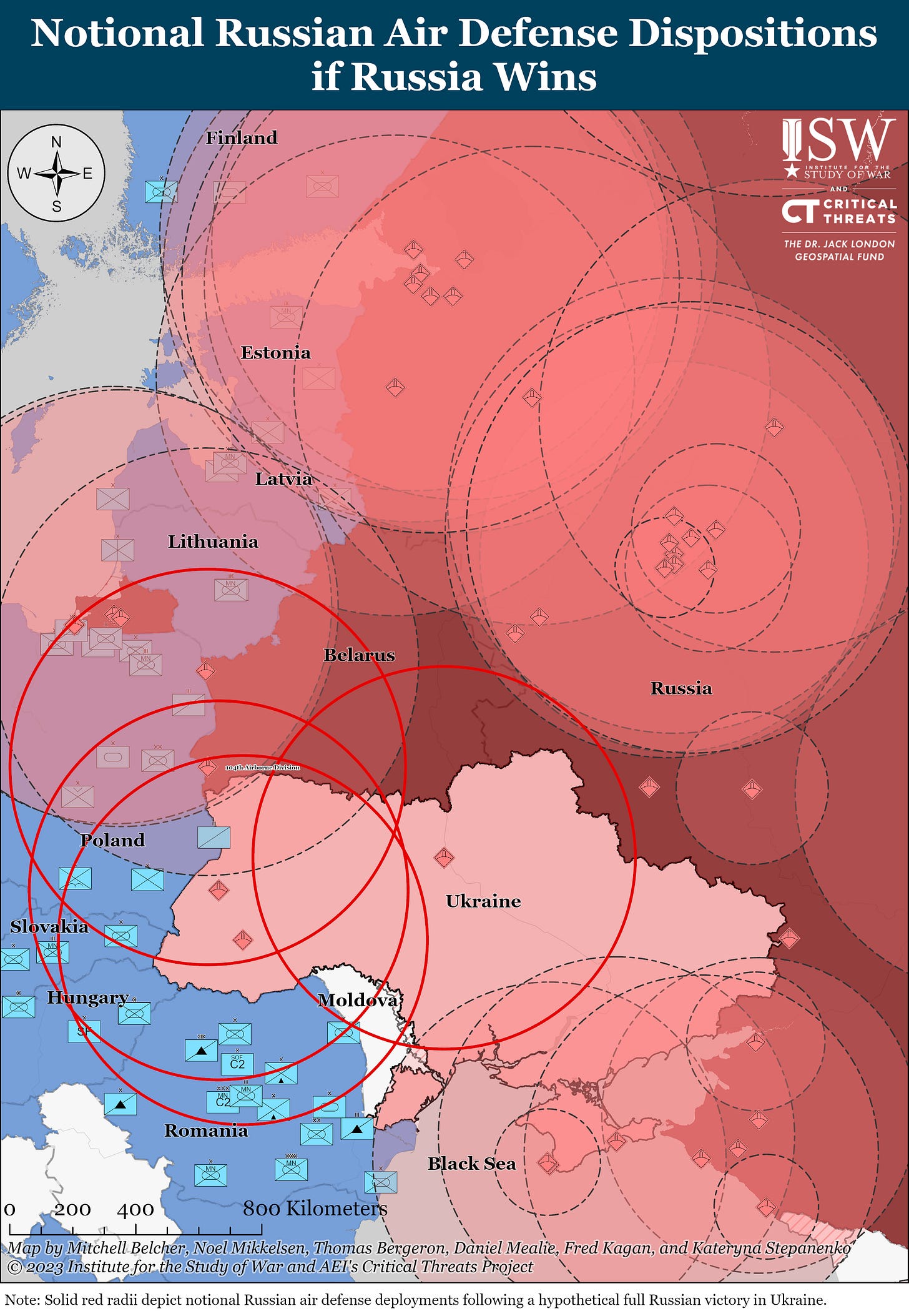

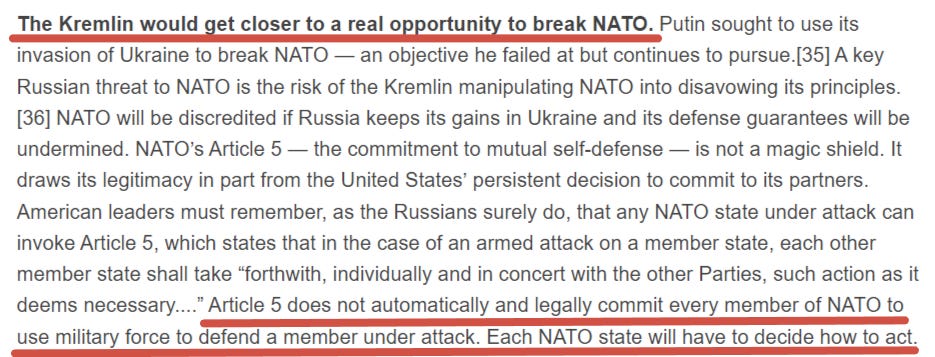


There is absolutely zero evidence that Russia has even the slightest desire to attack or invade or even defeat NATO proper. It has acted and will continue to act purely defensively. And no one really wants to spend 4 or 5% of GDP indefinitely on armies and weapons. Nor does anyone want to suck valuable manpower into the parasitic military--in fact the West can't, even if it wanted to. So we wind up back to where we started in December of 2021. When the war is over Russia makes an offer they can't refuse--a new comprehensive security arrangement for Europe. Negotiate and cap everything, provide de-militarized security zones for all borders and provide for mutual inspections. Trust but verify, in the immortal words of Ronnie boy. As for the US husbanding its forces to take on China-- completely insane, absolutely impossible. And everyone with any military sense knows it. In spite of all the elaborate calculations in these two reports, the West simply cannot compete with Russia and China militarily. This whole tragic escapade winds up being an undertaking by the Russians to get back to that magic moment in 2021 when they offered a comprehensive security deal. Unlike the West, neither Russia or China are interested in expansion or destabilizing anybody. Their resources and industrious populations are sufficient thank you very much. And in the case of China, they have a stable system under the Communist Party that works wonders. A comprehensive security deal is the real endgame, the real goal of the Russians. And this time it will be impossible to ignore them. Sounds impossibly sane doesn't it? Well circumstances, not sanity, may yet bring it about--and that old tried and true Soviet concept, the correlation of forces.
I must say, inspired by Simpiclius tireless work I worked tirelessly on my "As America Crumbles...: A Grim Chronicle Exploring the Evil Source of America’s Catastrophic Decline " book, diving deep into the labyrinth of corruption and legalized theft by the US government. 325 bibliographical entries :)
https://www.amazon.com/dp/B0CQR71WN3